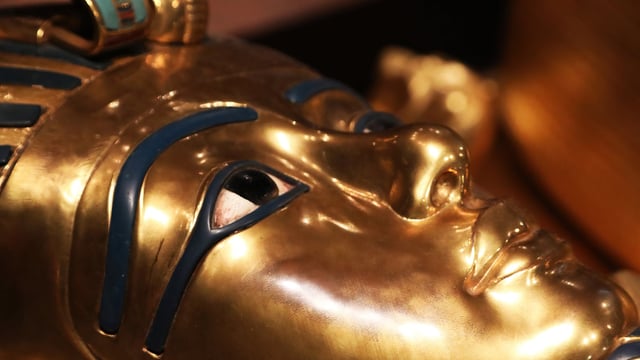- Sarah Nash
- Last Checked and/or Updated 9 December 2023
- No Comments
- Amazing Artefacts, Exhibitions, Photo Essays, Egyptomania
The exhibition King Tut: Treasures of the Golden Pharaoh was hailed by authorities in Egypt as the last exhibition of the famed Pharaoh’s funerary objects to tour internationally. “See them, visit them, before they return back to Egypt forever”, said Dr. Mostafa Waziry, Secretary General of Egypt’s Supreme Council of Antiquities.
The Touring Exhibition




The collection was on tour from March 2018 to early 2020, was made up of 150 objects from the tomb of Tutankhamun. Jewellery, sculptures and ritual objects join what is thought to be the oldest glove on earth, and the world’s oldest trumpet. Sixty of these artefacts have never travelled before. That is more than the number of artefacts that has ever been seen at once outside of Egypt. To put the hype around this exhibition into perspective, previous major travelling exhibitions contained only 55 of King Tut’s funerary artefacts.
But why the last? Until recently the 1000s of objects recovered from Tutankhamun’s tomb were in the Cairo Museum, many of which were on display. One of the gold chariots was on display in the Egyptian National Military Museum. In 2018 the last of King Tut’s objects were moved from these museums to the new museum near the Giza Pyramids. Scheduled to open fully in 2024, the Grand Egyptian Museum will tell the story of 3,000 years of ancient Egyptian history with over 100,000 artefacts. The new museum will also be the final resting place of the Tutankhamun collection. It is reported that around 7,000 square metres of display space has been allocated to this extraordinary collection of funerary objects.
Highlights of the Touring Exhibition



A close up of the neck of the vase. Faience was known as ‘tjehenet’ in the ancient Egyptian world, which means ‘dazzling’ or ‘brilliant’. It was a synthetic material and could be made in a variety of colours, although turqousie was the most common, as it was believed to represent life and fertility.



This painted calcite box, with a floral decoration on the valuted lid, contained two bundles of human hair. These probably belonged to Tutankhamun and Ankhesenamun. Found with a small ivory pomegranate, this may well have represented their marriage contract.

A wooden box inlaid with 47,000 individual pieces of ivory and ebony. An inscription suggests that it held gold jewellery that was used for Tutankhamun’s wedding.




This life-size statue of the Ka of Tutankhamun marks his passage from the dark night to his rebirth at dawn. The eyes are made from volcanic obsidian and his sandals are bronze. The black skin symbolises the fertility of the Nile, and the gold his divinity. It is one of a pair which stood guard in the tomb, the most complete examples of their kind ever found.

This gilded wooden statue of Ptah has three hieroglyphs on the sceptre, which stand for life, stability and sovereignty. Ptah was the god of Creator, and the patron of craftspeople and architects. He was central to Egyptian worship and was linked to the city of Memphis, which was also known as the ‘temple of the soul of Ptah’. The Ancient Greeks shortened this name, using it to refer to the whole country, eventually giving us the name ‘Egypt’.



The gold ba-bird pectoral decoration is holding ‘shen’ signs, which represent the eternal journey of the sun.



This Wesekh, or collar, was placed between the mummy’s layer of bandages. The hawk represents Horus, the god closely associated with the living Pharaoh. These collars were worn by gods and Pharaohs, and were often of such a weight that a counterpoise hung down between the shoulder blades of the wearer, to help them maintain balance.

Pharaohs carried a crook and flail, in honour of Osiris. The crook in particular became one of the many signs of a ruler. Tutankhamun would carry these symbols on formal occasions, thus confirming his divine authority to all present.



This representation of the solar hawk Horus, a gilded wooden hawk with a sun disk on its head, was part of the decoration included on a chariot. Tutankhamun’s tomb contained six chariots. Each of these had to be dismantled so that they could pass through the narrow entrance of the tomb, and assembled once inside the tomb.

Tutankhamun’s organs were kept in a canopic shrine, which contained a magnificent calcite chest. On top of this, two pairs of Tutankhamun heads faced each other, and slotted inside those, were four intricate gold coffinettes, each containing an embalmed organ. The coffinettes are replicas of the actual coffin. This particular coffinette held Tutankhamun’s liver.

This gilded wooden shield shows Tutankhamun wearing an Atef crown as he holds two lions by the tails. Lions were the most powerful animals of the natural and supernatural world, surrounding Egypt in the desert lands. By showing his mastery of these animals, he is showing his mastery over Egypt.

On this gilded wooden shield has the King is depicted as a Sphinx, trampling on Nubian enemies underfoot. The hills at the bottom make the hieroglyph ‘foreign land’, showing how he is conquering his enemies. Given the delicacy and subject matter of these two shields, they were almost certainly ceremonial rather than functional.


More on Ancient Egypt & Egyptomania
No other ancient civilisation holds our attention around the world today as much as ancient Egypt does. Europe’s fascination with Egypt is almost as old as antiquity itself, and dates back to the ancient Greeks and Alexander’s conquering of Egypt. For centuries now Egyptian artefacts have been sold to private collectors and museums. Consequently, there are now numerous collections of Egyptian antiquities all over the world.



